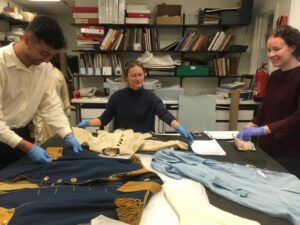Dressed For Success: a Step Change for the Dress History Collection at Museums & Galleries Edinburgh

The Project
Museums & Galleries Edinburgh’s dress history collection had been stored for many years in an unsuitable environment with poor access. This limited curatorial work and prevented researchers from visiting. The Dressed For Success project recruited volunteers to work alongside existing staff to document, condition check, photograph and rehouse the costume collection at the Museum Collections Centre. The project aims were:
- To improve the information on the collections management database.
- To aid the long-term preservation of the collection.
- To re-site the costume in a location more suitable for visitors and researchers.
- To enable items to be viewed without being handled wherever possible.
The project offered the chance for volunteers to gain new skills and knowledge from handling a wide variety of costume items. It was also an opportunity for two curators to become familiar with the entire dress history collection. This included the history curator with responsibility for dress and textiles, and the applied art curator who had not worked with the dress history collection before.
"It was an opportunity to become more involved in object handling and gain more experience in a museum collections environment… Both supervisors were always around to answer any questions and they also valued our opinions whenever we came across something unusual and had discussions about an object’s condition or provenance. I learnt a lot whilst working on this project and really appreciated the opportunity to meet and work with the staff and the other volunteers."
Volunteer Collections Assistant, Dressed for Success project
Additional Information
PROJECT FUNDING:
- This project cost £6622
- It was funded by the MGS Small Project Fund and City of Edinburgh Council
PROJECT DELIVERY:
- Duration of project: December 2018- April 2020
Challenges and Successes
- Approximately 200 items have now been fully catalogued, re-packed and stored in our accessible facility. Eighty have been photographed, enabling researcher access and sharing on digital platforms.
- Our main challenges were: Waiting for specialist costume boxes to arrive, which caused delays, and dealing with a larger number of items than first anticipated, as there were undocumented items in the store.
- MGS fully supported our request for an extension to the project, and for the re-direction of funds from packing materials to photographic equipment. Overall, the project ran smoothly, participants had a very positive experience, and we will use the project as a model for future work.
The impact it has made
The project’s key areas of impact were:
- Skills development: Of the six volunteers recruited, two have decided to pursue further study in preventive and textile conservation.
- Institutional knowledge: The dress history curator has a better knowledge of the entire collection. Shoes discovered during this project were the inspiration for the Museum of Edinburgh exhibition ‘Stepping Out’, which was also shared digitally online at capitalcollections.org.uk The applied art curator gained an understanding of another collection.
- Efficiency and access: The records for each item of costume are more complete, and condition reports enable us to assess items for possible research or display. The collection is now housed in boxes suitable for long-term preservation, and items are packed so that they can be viewed without handling wherever possible.
- Reputation and audience-building: Promotion of Dressed for Success increased awareness of the dress history collection, leading to increased requests for visits from special interest groups such as costume societies.
Lesson learned
- We learned that the dress history collection was bigger than we realised, due to unaccessioned material contained in the old store. This is useful for planning during the new inventory project we’re currently undertaking.
- We learned to make sure we factor in lead-in times for conservation supplies that are not commonly held in stock when working on large projects, and to allocate dedicated storage space to boxes and other materials before they’re used.
- Developing the workflows for processing each item of costume was useful for planning our most recent inventory work.
Guidance
- Develop and practice your workflows before beginning to train your volunteers, so that you are confident in your processes and outcomes.
- Consider involving staff in your project from other sections of your organisation, if they are interested in developing new skills, or have skills that could be useful in your project.
- You don’t have to select volunteers who have carried out identical work to that offered by your project. A team with diverse experience can work really well together as a unit.
- If one of your project aims is to better serve your community or a specific audience, make sure you use social media and other platforms to share the work as it progresses, to raise awareness of what you’re doing.
- If your project changes shape over time, speak to MGS about your new needs and how they can support you.
If you would like more information about this project please contact Jacob O’Sullivan, MGS Collections and Engagement Manager, email: jacobos@museumsgalleriesscotland.org.uk